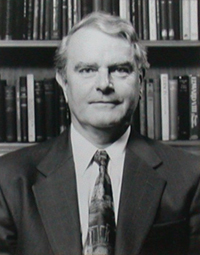Dora Minnie Crouch
ID# 5422, b. 4 March 1903, d. December 1985
- Charts
- Willym Dernely (c.1516-)

Birth:
Dora Minnie Crouch was born on 4 March 1903
.
Dora Minnie Crouch was the daughter of William Crouch and Minnie Clara (?)

Marriage:
Dora Minnie Crouch married Eric Dearnaley, son of James Dearnaley and Mary Boulton, about August 1929 at Manchester, Lancashire, England,
.

Death:
Dora Minnie Crouch died in December 1985 at Oxford R.D., Oxfordshire, England, at age 82 years and 8 months
Indexed as Dora Minnie Dearnaley, born 4 March 1903.
Child of Dora Minnie Crouch and Eric Dearnaley
- Geoffrey Dearnaley+ b. 22 Jun 1930, d. 5 May 2009
Geoffrey Dearnaley
ID# 5423, b. 22 June 1930, d. 5 May 2009
- Charts
- Willym Dernely (c.1516-)

Geoffrey Dearnaley
(1930-2009)
from the Fellows of the Royal Society
in the Museum at the Cavendish Laboratory
(1930-2009)
from the Fellows of the Royal Society
in the Museum at the Cavendish Laboratory

Birth:
Geoffrey Dearnaley was born on 22 June 1930 at Manchester, Lancashire, England,
.
Geoffrey Dearnaley was the son of Eric Dearnaley and Dora Minnie Crouch.

Death:
Geoffrey Dearnaley died on 5 May 2009 at age 78 years, 10 months and 13 days
.

Geoffrey Dearnaley was a physicist, a Fellow of the Royal Society, and did work on ion implantation for the British government at the Atomic Energy Research Establishment at Harwell in Berkshire. Amusingly, he had a colleague and friend with the surname Whitehead (they used to share a car to commute to work), who was likely descended from the same Whitehead family which had several lawsuits with the Dearnaley/Dearnley family back during the middle ages.
source: family member
Geoffrey Dearnaley. 22 June 1930 — 5 May 2009
Geoffrey Dearnaley was distinguished for seminal contributions to the fields of low-energy nuclear physics, semiconductor detectors for nuclear radiations, and ion channelling at megaelectronvolt energies. Especially significant was his pioneering research on the ion implantation of semiconductor materials, ion implantation of metals, and ion-assisted coatings. He had a special skill in translating complex scientific concepts into industrially exploitable technologies, so his fundamental research contributions were taken up by industry in the automotive sector, electronics, and engineering. His innovations were seminal in the designs of several ion implantation systems, such as the Lintott implanter, that remained a major force in semiconductor implantation after many years. Later, he led the way with his second-generation ‘Blue Tank’ facility. It was his idea to improve the wear and oxidation resistance of metals by ion implantation, leading to successes as varied as improved resistance to high-temperature corrosion of nuclear fuel cladding and to notable reductions in wear of replacement hip joints. Geoffrey Dearnaley was a fundamental physicist who made significant original contributions to many scientific fields, and his understanding of both science and technology successfully showed industry how to exploit them.
*© 2010 The Royal Society
http://rsbm.royalsocietypublishing.org/content/56/41.abstract.
source: family member
Geoffrey Dearnaley. 22 June 1930 — 5 May 2009
Geoffrey Dearnaley was distinguished for seminal contributions to the fields of low-energy nuclear physics, semiconductor detectors for nuclear radiations, and ion channelling at megaelectronvolt energies. Especially significant was his pioneering research on the ion implantation of semiconductor materials, ion implantation of metals, and ion-assisted coatings. He had a special skill in translating complex scientific concepts into industrially exploitable technologies, so his fundamental research contributions were taken up by industry in the automotive sector, electronics, and engineering. His innovations were seminal in the designs of several ion implantation systems, such as the Lintott implanter, that remained a major force in semiconductor implantation after many years. Later, he led the way with his second-generation ‘Blue Tank’ facility. It was his idea to improve the wear and oxidation resistance of metals by ion implantation, leading to successes as varied as improved resistance to high-temperature corrosion of nuclear fuel cladding and to notable reductions in wear of replacement hip joints. Geoffrey Dearnaley was a fundamental physicist who made significant original contributions to many scientific fields, and his understanding of both science and technology successfully showed industry how to exploit them.
*© 2010 The Royal Society
http://rsbm.royalsocietypublishing.org/content/56/41.abstract.
Child of Geoffrey Dearnaley
- Nicholas John Dearnaley+ b. 2 Jan 1970, d. 24 Oct 2006
Nicholas John Dearnaley
ID# 5426, b. 2 January 1970, d. 24 October 2006

Birth:
Nicholas John Dearnaley was born on 2 January 1970 at Oxford, Oxfordshire, England,
.
Nicholas John Dearnaley was the son of Geoffrey Dearnaley.

Death:
Nicholas John Dearnaley died on 24 October 2006 at Cambridge, Cambridgeshire, England, at age 36 years, 9 months and 22 days
Nicholas John Dearnaley (Coll, 83-8), l.c. of R. D. Aulae Prae. Trin.Coll., Camb; Nat.Sci.
Married and started a family while at Cambridge, and continued to live in Cambridgeshire thereafter.
Worked as a software engineer for a number of companies, most recently i-Merge.
Died suddenly of a heart attack on 24 October 06, survived by his wife
and three sons and by a daughter whom he never knew as she was born in December 06.
The Trusty Servant (June 2007) - Old Wykehamists (Winchester College, Hampshire, England)
https://wyksoc.com/Document.Doc?id=4.
Married and started a family while at Cambridge, and continued to live in Cambridgeshire thereafter.
Worked as a software engineer for a number of companies, most recently i-Merge.
Died suddenly of a heart attack on 24 October 06, survived by his wife
and three sons and by a daughter whom he never knew as she was born in December 06.
The Trusty Servant (June 2007) - Old Wykehamists (Winchester College, Hampshire, England)
https://wyksoc.com/Document.Doc?id=4.